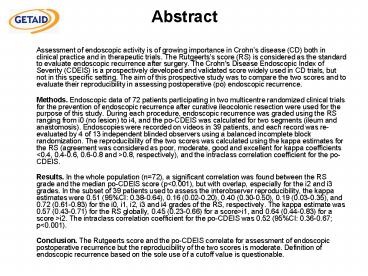Abstract PowerPoint PPT Presentation
1 / 10
Title: Abstract
1
Abstract
- Assessment of endoscopic activity is of growing
importance in Crohns disease (CD) both in
clinical practice and in therapeutic trials. The
Rutgeertss score (RS) is considered as the
standard to evaluate endoscopic recurrence after
surgery. The Crohn's Disease Endoscopic Index of
Severity (CDEIS) is a prospectively developed and
validated score widely used in CD trials, but not
in this specific setting. The aim of this
prospective study was to compare the two scores
and to evaluate their reproducibility in
assessing postoperative (po) endoscopic
recurrence. - Methods. Endoscopic data of 72 patients
participating in two multicentre randomized
clinical trials for the prevention of endoscopic
recurrence after curative ileocolonic resection
were used for the purpose of this study. During
each procedure, endoscopic recurrence was graded
using the RS ranging from i0 (no lesion) to i4,
and the po-CDEIS was calculated for two segments
(ileum and anastomosis). Endoscopies were
recorded on videos in 39 patients, and each
record was re-evaluated by 4 of 13 independent
blinded observers using a balanced incomplete
block randomization. The reproducibility of the
two scores was calculated using the kappa
estimates for the RS (agreement was considered as
poor, moderate, good and excellent for kappa
coefficients lt0.4, 0.4-0.6, 0.6-0.8 and gt0.8,
respectively), and the intraclass correlation
coefficient for the po-CDEIS. - Results. In the whole population (n72), a
significant correlation was found between the RS
grade and the median po-CDEIS score (plt0.001),
but with overlap, especially for the i2 and i3
grades. In the subset of 39 patients used to
assess the interobserver reproducibility, the
kappa estimates were 0.51 (95CI 0.38-0.64),
0.16 (0.02-0.20), 0.40 (0.30-0.50), 0.19
(0.03-0.35), and 0.72 (0.61-0.83) for the i0, i1,
i2, i3 and i4 grades of the RS, respectively. The
kappa estimate was 0.57 (0.43-0.71) for the RS
globally, 0.45 (0.23-0.66) for a scoregti1, and
0.64 (0.44-0.83) for a score gti2. The intraclass
correlation coefficient for the po-CDEIS was 0.52
(95CI 0.36-0.67 plt0.001). - Conclusion. The Rutgeerts score and the po-CDEIS
correlate for assessment of endoscopic
postoperative recurrence but the reproducibility
of the two scores is moderate. Definition of
endoscopic recurrence based on the sole use of a
cutoff value is questionable.
2
Introduction
- Endoscopic recurrence is largely used as endpoint
in clinical trials for postoperative prevention
in Crohns disease. To be used in this setting,
endoscopic score should be simple, reproducible
and modified by therapies. - The Rutgeerts score (RS) is considered as the
standard because this five-scale score has been
shown to be correlated with the delay of clinical
recurrence, but it has never been strictly
validated. - The CDEIS (Crohns Disease Endoscopic Index of
Severity) is a well validated score in
ileocolonic active disease, but has never been
evaluated for postoperative endoscopic
recurrence. - Aims of the study
- To compare the Rutgeerts score and the
postoperative CDEIS (po-CDEIS) - To study reproducibility of the two scores
- To study factors predictive of endoscopic
recurrence.
3
Methods
- Multicentre prospective study.
- Endoscopic data coming from two clinical trials
for prevention of endoscopic recurrence after
ileocolonic resection. - Inclusion criteria
- right ileocolectomy
- curative resection (resection of all macroscopic
lesions) - 4 types of evaluation were consigned after each
colonoscopy performed 6-24 months after surgery
using a standardized form including - Qualitative global evaluation of severity EGQV
(from 0 no lesion to 4, severe) - Quantitative global evaluation Visual Analogic
Scale (10 cm) - Rutgeerts score RS (i,0 à i,4)
- po-CDEIS calculated for ileum and anastomosis
taking into account presence of superficial and
of deep lesions, surface of ulcerations and
surface of lesions. - Video recording for study of reproducibility.
4
Results-1
- Study population
- N 72
- Age (years) 31 (27-35)
- Female 39 (54)
- Smokers 20 (28)
- Duration (months) 28 (7-88)
- Prior surgery 13 (18)
- Penetrating disease 33 (46)
- Disease locationsmall bowel 41
(58small bowel colon 28 (39)colon
2 (3)
Médiane (percentiles)
2Ileoscopy not done (n3) Ileoileal anastomosis
(n1) Incomplete form (n1)
1GETAID 2001-1 azathioprine vs mesalazine and
GETAID 2001-2 Lactobacillus LA1 vs placebo
5
Results-2 Elementary lesions
ILEON
ANASTOMOSIS
Grade 1 ulcerations ?5 or ?50
circumferencepassable stenosislocalized
erythema or swollen mucosapseudopolyps or healed
ulcerations ?5
- Ulpro deep ulcerations
- Ulsup superficial ulcerations
- Ulpun punctiform ulcerations
- Stul ulcerated stenosis
- Stnul non ulcerated stenosis
- Eryfr frank erythema
- Mbsfl swollen mucosa
- Ppoly pseudopolyp
- Ciulc healed ulceration
6
Results-3 po-CDEIS correlation study
Plt0,001
- Kruskal-Wallis test
Plt0,001
Rutgeerts score
Kruskal-Wallis test
Spearmans correlation test
Median (percentiles) statistic test
7
Results-4 Rutgeertss score correlation study
n16
n29
n8
n5
n14
10
Plt0,001
8
Quantitative evaluation
6
Qualitative evaluation
4
2
0
0
1
2
3
4
Rutgeertss score
Rutgeertss score
Test de Kruskal-Wallis
8
Results-5 Reproducibility
Elementary lesions
ileon
kappa
anastomosis
0.5
0.4
0.3
0.2
0.1
0
-0.1
-0.2
-0.3
ulpro
ulsup
ulpun
stul
stnul
eryfr
mbsfl
ppoly
ciulc
Rutgeertss score
kappa
good
po-CDEIS
moderate
Intraclass correlation coefficient
0.52 (95CI 0.36-0.67)
poor
9
Results-6 Factors predictive for postoperative
endoscopic recurrence (multivariate analysis)
Disease behavior
Tobacco
50
50
45
45
40
40
35
35
30
30
25
25
non penetrating
non smokers
20
20
smokers
penetrating
15
15
10
10
5
5
0
0
0
1
2
3
4
0
1
2
3
4
Rutgeertss score
Rutgeertss score
Odds ratio, CI 95
10
Conclusion
- Rutgeertss score and po-CDEIS are well
correlated. - Reproducibility of the two scores is moderate.
- The choice of a cutoff value to define endoscopic
recurrence is questionable. The use of a
quantitative score like the po-CDEIS in clinical
trials should be preferred. - Our study confirms that smoking and penetrating
behavior are independant factors predictive of
severe endoscopic recurrence.

